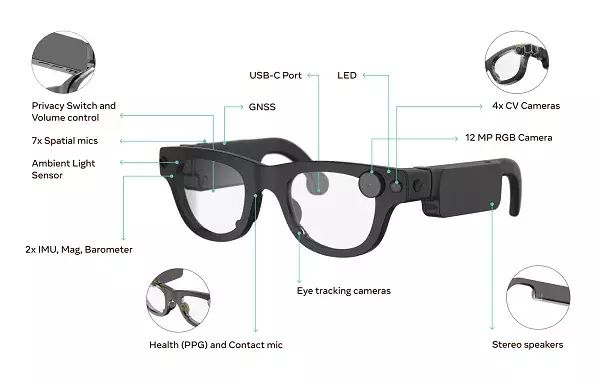Meta has consistently been at the forefront of cutting-edge technology, particularly in the realm of augmented reality (AR). As it works towards the launch of its highly anticipated second-generation “Aria” AR glasses, the company has released new insights and details that reflect its ambitions and the potential impact of this device on everyday life. With an aim to integrate advanced technology while simultaneously prioritizing comfort, style, and affordability, Meta is making strides to redefine what wearable AR can be.
The Aria Gen 2 glasses signify a series of impressive advancements, particularly in terms of design and functionality. Weighing between 74 to 76 grams, depending on the size, the glasses are engineered to offer a lightweight experience without sacrificing performance. One particularly exciting feature is the introduction of folding arms, a testament to the intricate engineering that enables users to conveniently store and transport these modern marvels. The decision to provide eight different sizes accounts for diverse human anatomies, bridging a crucial gap in personalized technology.
The Power of Sensory Integration
Augmented reality requires sensory input to create immersive experiences, and Meta’s relentless focus on honing the sensor suite for the Aria Gen 2 is a key feature that sets it apart. The improved camera sensors are designed to function effectively even in varying light conditions, a significant leap from the previous model. This means that users will be able to engage with digital overlays seamlessly, regardless of their environment.
Additionally, the integration of a contact microphone within the nosepad marks a pivotal enhancement. This feature aims to amplify audio capture capabilities, particularly in noisy settings, making interactions more user-friendly. AR’s potential lies in its ability to blend digital and physical worlds; therefore, ensuring a smooth interaction through features like eye and hand tracking is crucial. These technological advancements aim to foster a more fluid and intuitive user experience, inviting individuals to navigate their environments in innovative ways.
Changing the Way We Interact
Mark Zuckerberg has articulated a vision where practical, connected glasses become what he refers to as a “holy grail” device, capable of replacing smartphones as the primary interface for communication and interaction. This perspective brings with it both excitement and skepticism. While the thought of people waving their hands and ‘poking’ at the air might evoke feelings of uncertainty, it’s essential to recognize that humanity has always adapted to new modes of communication. The integration of augmented reality could fundamentally alter social interactions, enhancing our ability to connect by merging digital content with our physical surroundings.
The ambitious plans set forth for the Aria Gen 2 also include opening the platform to external developers later this year. This strategy is critical as it fosters a collaborative environment that can lead to unexpected innovations. When developers from various backgrounds—ranging from gaming to education—are given access to a new technology, the potential applications become virtually limitless. This collective creativity is poised to catalyze the next wave of AR experiences that could reshape how we view and interact with reality.
The Road Ahead for AR
As we gaze into the future, the planned consumer launch of Aria Gen 2 in 2027 feels both distant and imminent. In a rapidly evolving technological landscape, five years can seem like an eternity, filled with potential disruptions and breakthroughs. Meta’s commitment to refining their AR glasses could theoretically set a standard against which future devices will be measured. While skepticism about the viability and practicality of such technology is natural, it’s essential to maintain an open mind about the transformative possibilities that a successful AR experience can provide.
This journey into augmented reality is not merely about creating another gadget; it’s about reimagining daily interactions and integrating the digital world more fully into human experience. Meta’s approach reveals insights not just into product development, but also into the broader perception of technology in our lives—striving for a future where digital presence complements, rather than complicates, real-world experiences. As we enter this new chapter of connectivity, the excitement surrounding innovation must be balanced with critical conversations about privacy, usability, and the implications of living side-by-side with artificially enhanced realities.

